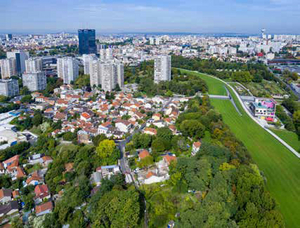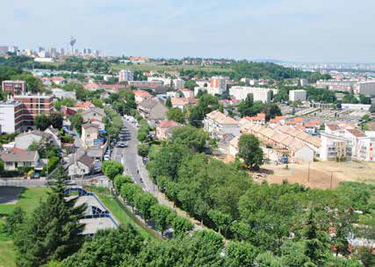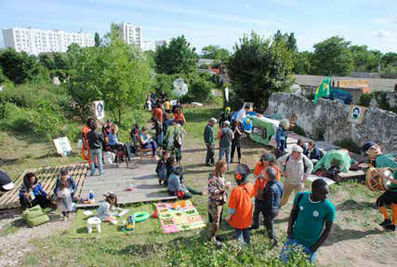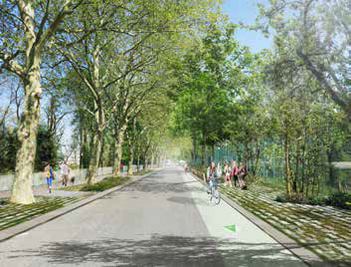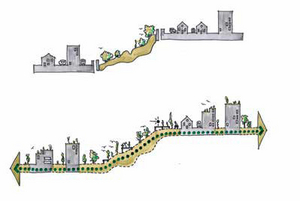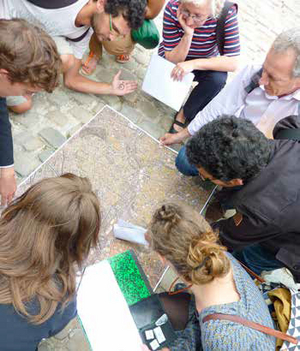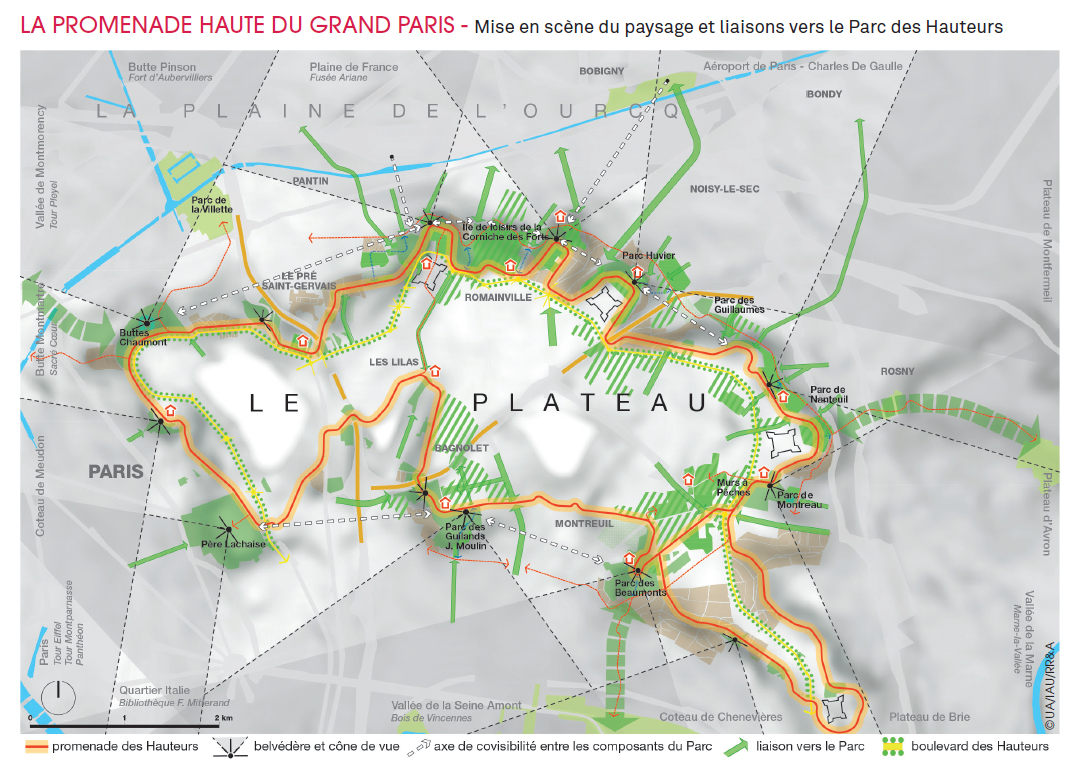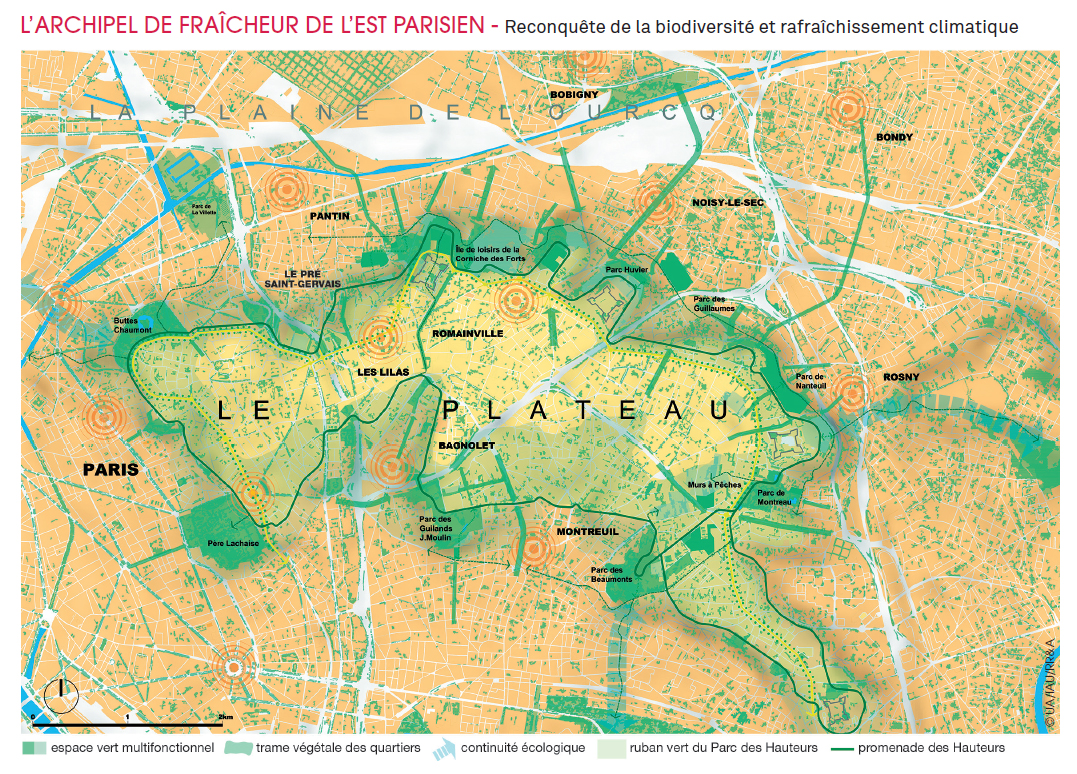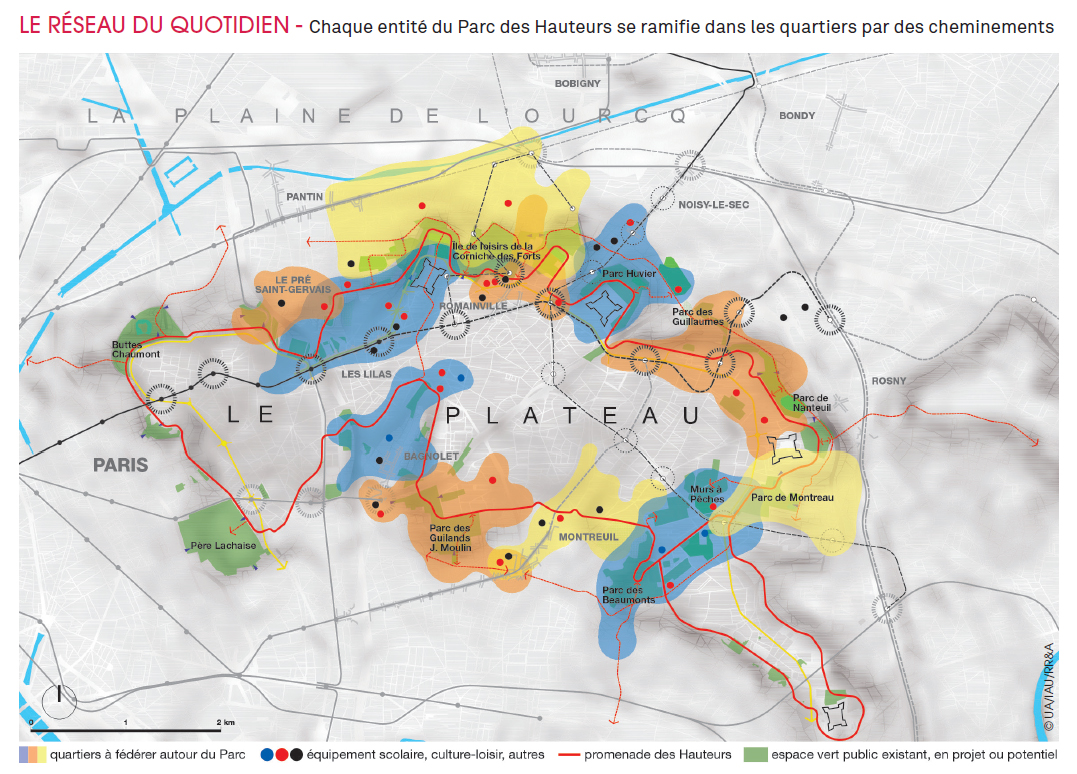The Parc des Hauteurs Project
The Parc des Hauteurs Project is about unwraping the lost geography of the Eastern Paris hills by reconnecting patchy open space into a single park system. First designed by the Institut Paris Region as a green infrastructure supporting urban, recreative, ecological, climate-mitigation functions, it is now being implemented by the Est Ensemble local authority with many other partners.
Weaving spaces into a park
The Parc des Hauteurs project is about revealing the unique landscape potential of the slopes of a limestone plateau by weaving together currently fragmented open spaces. Over time, the idea is to create a single 320 hectare public park system by knitting together existing open spaces (woodlands, parks, sports grounds, allotments, disused quarries, military wastelands and other brownfield sites) with an extensive ringshaped belvedere promenade. The whole project is envisioned as a ‘park of parks’, multi-use green infrastructure supporting social and ecological functions, as well as a driver for urban transformation. It draws inspiration from creative urban park strategies, such as the Emscher Park in the Ruhr, the Ridge Park in Singapore, and the Parc des Coteaux in Bordeaux.
Initiated by the Institut Paris Region in 2016, the project is steered by Est Ensemble, an inter-municipal local authority with planning powers, about the size of the London Borough of Newham (38 km²) and with a population of 420,000. However, the park project goes beyond its administrative borders, involving ten municipalities including Paris and two municipalities in other inter-municipal authorities. Altogether about 920,000 people live in the larger catchment area of the future park system, many of whom at present have no access to a green space within walking distance from their home.
The urban transformation of the area is being stimulated by the delivery of new transport infrastructure: the M11 metro expansion due in 2023, the T1 tramway expansion in 2026, and the metropolitan ring metro M15 planned for just after 2030. Simulations based on outline planning permissions suggest that these could add 60,000 people to the existing population by 2030, and yet without the supply of new green space growing at the same rate. The park system project plans therefore to increase the amount of accessible open space by 40 per cent, from 230 hectares to 320 hectares by around 2030.
The project includes a number of characteristics:
- The Promenade des Hauteurs is to be a green pedestrian and bike park connector covering 30km and giving a 360° panoramic view over the city;
- Cool Nature is about preserving natural habitats and enhancing biodiversity;
- The Living Park is about how the park could become a destination, stimulate a new way of living and a greener economy on the plateau; and
- Local Networks looks at improving access to the different components of the park by improving the greening and walkability of local streets and squares.
Design and governance
The design process of the Parc des Hauteurs has been incremental. The idea was initially put forward by the author as part of the 1995 Regional Green Plan, but at the time it drew no support from the public authorities. Since 2016, the Est Ensemble local authority together with the Institut Paris Region as strategic advisor, has been consolidating the project’s vision, objectives, priorities and governance, bringing together elected officials, technical experts and potential partners around the table within a so-called Park Lab (Labos du Parc). Est Ensemble has also developed community outreach and cultural events in which over 800 people from different perspectives have taken part.
The main priority today is the design and implementation of the park connector, the Promenade des Hauteurs. In 2019, the French landscape consultancy, Agence Ter, was commissioned by Est Ensemble to lead a multi-disciplinary team to draw outline designs for the 30 km promenade ring (plus two 12km green links) and involving the transformation and greening of many existing streets. The political and technical framework for the future detail design competition, financing, phasing and delivery process for the promenade is currently being prepared. A €15M budget has been set aside to deliver a first significant stretch by 2026, with the complete implementation expected in the early 2030s. Short stretches of the promenade may be delivered with a temporary design for the Paris Olympics in 2024.
Altogether about 920,000 people live in the larger catchment area of the future park system, many of whom at present have no access to a green space within walking distance from their home
Since 2020, the Parc des Hauteurs project’s principles have been embedded in the 2020 Est Ensemble Development Masterplan (Plan local d’urbanisme intercommunal - PLUi) and the overall strategy is now supported by the Paris Region, the Grand Paris Metropolitan Council and other partners. The transformative capacity of the project has also brought together several levels of government. It is increasingly viewed as a transitional pilot project. However, the sheer number of stakeholders and mostly public land owners, each with a different political agenda, slows down decisions. There are conflicting interests over the future use of former quarries and military sites that need to be clarified through an informed dialogue, i.e. whether they should become nature reserves or open to the public for recreation.
Another sensitive question is how to reduce on-street parking in order to make room for pedestrians, bikes and greening along the Promenade.
Additional funding will also be crucial for the project to be delivered in its different components as, for instance, consolidating former gypsum quarries is very costly. An efficient governance structure called Natural Urban Park (Parc naturel urbain) could help to bring together all of the stakeholders to agree a shared funding and delivery agenda.
With open and natural spaces becoming increasingly valued in large city regions like Paris, it is essential to achieve new compromises if we are to promote a high intensity and diversity of uses. The Parc des Hauteurs project is about this: opening up a magical place of open skies, seasons, wind, trees and animal life in the dense core of the city region. It is about building a healthier urban environment for everyone’s benefit. It is certainly worthy of attention for those seeking to deliver well-connected and networked green infrastructure.
Paul Lecroart, Senior Urbanist, L’Institut Paris Region (Planning Agency for Paris Metropolitan Region). Adapted from Urban Design magazine issue #162, Spring 2022
See also
This page is linked to the following category :
Urban planning

